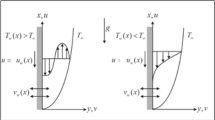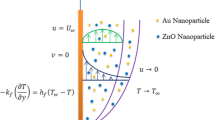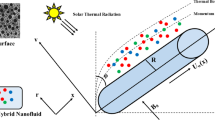Abstract
Solar radiative energy represents an important source of renewable energy. Of late, hybrid colloidal nanodispersion as an elevated heat transport agent acquires immense interest among researchers rather than unitary nanoliquids. The aim of this investigation was to quantify the flow patterns and heat transfer behaviour of hybrid nanoliquids in presence of nonlinear solar radiation for various solar thermal apparatus. Alumina–copper nanoingredients with water as host fluid are considered. The leading PDEs of our system are turned into ODEs by using prevalent similarity transformation. After that those ODEs have been solved by RK-4-based shooting method. Subsequently, the influences of relevant parameters on the heat transfer of fluid have been talked over on behalf of graphical and tabular approach. Extracted results are verified with experimental plus simulated data. Results communicate that solar radiation fosters heat transport in suction. Hybrid solution exhibits impressive increment in heat transport for suction. Though injection reduces the effect, the decay rate is slower for hybrid nanocomposite. Flipping nature of velocity is perceived for Reynolds number, rotational parameter, and nanoparticle concentration except the variations of suction/injection parameter. We believe that this comprehensive investigation will have potential applications in solar thermal power fabrication, solar ponds, solar thermo electric cells, etc.

























Similar content being viewed by others

References
Choi SUS. Enhancing thermal conductivity of fluids with nanoparticles. In: Siginer DA, Wang HP, editors. Developments and applications of non-Newtonian flows, vol. 66. New York: ASME; 1995.
Teng TP, Hung YH, Teng TC, Mo HE, Hsu HG. The effect of alumina/water nanofluid particle size on thermal conductivity. Appl Therm Eng. 2010;30:2213–8.
Tiara AM, Chakraborty S, Sarkar I, Ashok A, Pal SK, Chakraborty S. Heat transfer enhancement using surfactant based alumina nanofluid jet from a hot steel plate. Exp Therm Fluid Sci. 2017;89:295–303.
Wei X, Wang L. Synthesis and thermal conductivity of microfluidic copper nanofluids. Particuology. 2010;8:262–71.
Lee S, Choi SUS, Li S, Eastman JA. Measuring thermal conductivity of fluids containing oxide nanoparticles. J Heat Transf. 1999;121(2):280–9.
Choi SUS, Zhang ZG, Yu W, Lockwood FE, Grulke EA. Anomalous thermal conductivity enhancement in nanotube suspensions. Appl Phys Lett. 2001;79(14):2252–4.
Eastman JA, Choi SUS, Li S, Yu W, Thompson LJ. Anomalously increased effective thermal conductivities of ethylene glycol-based nanofluids containing copper nanoparticles. Appl Phys Lett. 2001;78(6):718–20.
Fan J, Wang L. Review of heat conduction in nanofluids. J Heat Transf. 2011;133(4):040801.
Fakour M, Vahabzadeh A, Ganji DD. Study of heat transfer and flow of nanofluid in permeable channel in the presence of magnetic field. Propuls Power Res. 2015;4(1):50–62.
Karimipour A, Nezhad AH, D’Orazio A, Esfe MH, Safaei MR, Shirani E. Simulation of copper–water nanofluid in a microchannel in slip flow regime using the lattice Boltzmann method. Eur J Mech B Fluids. 2015;49:89–99.
Santra AK, Sen S, Chakraborty N. Study of heat transfer due to laminar flow of copper–water nanofluid through two isothermally heated parallel plates. Int J Therm Sci. 2009;48:391–400.
Hoa CJ, Chiou YH, Yan WM, Ghalambaz M. Cooling performance of Al2O3-water nanofluid flow in a minichannel with thermal buoyancy and wall conduction effects. Case Stud Therm Eng. 2018;12:833–42.
Acharya N, Das K, Kundu PK. The squeezing flow of Cu–water and Cu–kerosene nanofluids between two parallel plates. Alex Eng J. 2016;55:1177–86.
Sheikholeslami M, Ganji DD. Magneto hydrodynamic flow in a permeable channel filled with nanofluid. Sci Iran B. 2014;21(1):203–12.
Makinde OD, Mabood F, Ibrahim SM. Chemically reacting on MHD boundary layer flow of nanofluids over a nonlinear stretching sheet with heat source/sink and thermal radiation. Therm Sci. 2018;22:495–506.
Mabood F, Khan WA, Makinde OD. Hydromagnetic flow of a variable viscosity nanofluid in a rotating permeable channel with hall effects. J Eng Thermophys. 2017;26:553–66.
Sheikholeslami M, Mahian O. Enhancement of PCM solidification using inorganic nanoparticles and an external magnetic field with application in energy storage systems. J Clean Product. 2019;215:963–77.
Sheikholeslami M. New computational approach for exergy and entropy analysis of nanofluid under the impact of Lorentz force through a porous media. Comput Methods Appl Mech Eng. 2019;344:319–33.
Sheikholeslami M, Haq R, Shafee A, Li Z. Heat transfer behavior of nanoparticle enhanced PCM solidification through an enclosure with V shaped fins. Int J Heat Mass Transf. 2019;130:1322–42.
Sheikholeslami M, Haq R, Shafee A, Li Z, Elaraki YG, Tlili I. Heat transfer simulation of heat storage unit with nanoparticles and fins through a heat exchanger. Int J Heat Mass Transf. 2019;135:470–8.
Sheikholeslami M, Jafaryar M, Shafee A, Li Z, Haq R. Heat transfer of nanoparticles employing innovative turbulator considering entropy generation. Int J Heat Mass Transf. 2019;136:1233–40.
Sheikholeslami M, Jafaryar M, Hedayat M, Shafee A, Li Z, Nguyen TK, Bakouri M. Heat transfer and turbulent simulation of nanomaterial due to compound turbulator including irreversibility analysis. Int J Heat Mass Transf. 2019;137:1290–300.
Sheikholeslami M, Jafaryar M, Ali JA, Hamad SM, Divsalar A, Shafee A, Nguyen TK, Li Z. Simulation of turbulent flow of nanofluid due to existence of new effective turbulator involving entropy generation. J Mol Liq. 2019;291:111283.
Sheikholeslami M, Rezaeianjouybari B, Darji M, Shafee A, Li Z, Nguyen TK. Application of nano-refrigerant for boiling heat transfer enhancement employing an experimental study. Int J Heat Mass Transf. 2019;141:974–80.
Mabood F, Nayak MK, Chamkha AJ. Heat transfer on the cross flow of micropolar fluids over a thin needle moving in a parallel stream influenced by binary chemical reaction and Arrhenius activation energy. Eur Phys J Plus. 2019;134:427. https://doi.org/10.1140/epjp/i2019-12716-9.
Zeeshan A, Ellahi R, Mabood F, Hussain F. Numerical study on bi-phase coupled stress fluid in the presence of Hafnium and metallic nanoparticles over an inclined plane. Int J Numer Methods Heat Fluid Flow. 2019;29:2854–69. https://doi.org/10.1108/HFF-11-2018-0677.
Mabood F, Ibrahim SM, Khan WA. Effect of melting and heat generation/absorption on Sisko nanofluid over a stretching surface with nonlinear radiation. Phys Scr. 2019;94:065701.
Ibrahim SM, Kumar PV, Lorenzini G, Lorenzini E, Mabood F. Numerical study of the onset of chemical reaction and heat source on dissipative MHD stagnation point flow of Casson nanofluid over a nonlinear stretching sheet with velocity slip and convective boundary conditions. J Eng Thermophys. 2017;26:256–71.
Acharya N, Das K, Kundu PK. On the heat transport mechanism and entropy generation in a nozzle of liquid rocket engine using ferrofluid (CoFe2O4): a computational framework. J Comput Des Eng. 2019. https://doi.org/10.1016/j.jcde.2019.02.003.
Acharya N, Das K, Kundu PK. Influence of multiple slips and chemical reaction on radiative MHD Williamson nanofluid flow in porous medium: a computational framework. Multidiscip Model Mater Struct. 2019;15(3):630–58.
Acharya N. Active-passive controls of liquid di-hydrogen mono-oxide based nanofluidic transport over a bended surface. Int J Hydrogen Energy. 2019;44(50):27600–14.
Hatami M, Ganji DD. Heat transfer and nanofluid flow in suction and blowing process between parallel disks in presence of variable magnetic field. J Mol Liq. 2014;190:159–68.
Ullah I, Waqas M, Hayat T, Alsaedi A, Khan MI. Thermally radiated squeezed flow of magneto-nanofluid between two parallel disks with chemical reaction. J Therm Anal Calorim. 2018. https://doi.org/10.1007/s10973-018-7482-6.
Mirzaei M, Dehghan M. Investigation of flow and heat transfer of nanofluid in microchannel with variable property approach. Heat Mass Transf. 2013;49:1803–11.
Abdollahi A, Mohammed HA, Vanaki SM, Osia A, Haghighi MRG. Fluid flow and heat transfer of nanofluids in microchannel heat sink with V-type inlet/outlet arrangement. Alex Eng J. 2017;56:161–70.
Mohyud-Din ST, Khan U, Hassan SM. Numerical investigation of magnetohydrodynamic flow and heat transfer of copper–water nanofluid in a channel with non-parallel walls considering different shapes of nanoparticles. Adv Mech Eng. 2016;8(3):1–9.
Sarkar J, Ghosh P, Adil A. A review on hybrid nanofluids: recent research, development and applications. Renew Sustain Energy Rev. 2015;43:164–77.
Chamkha AJ, Miroshnichenko IV, Sheremet MA. Numerical analysis of unsteady conjugate natural convection of hybrid water-based nanofluid in a semicircular cavity. J Therm Sci Eng Appl. 2017;9:041004.
Gorla RSR, Siddiqa S, Mansour MA, Rashad AM, Salah T. Heat source/sink effects on a hybrid nanofluid-filled porous cavity. J Thermophys Heat Transf. 2017;31:847–57.
Selvakumar P, Suresh S. Use of Al2O3–Cu/water hybrid nanofluid in an electronic heat sink. IEEE Trans Compon Packag Manuf Technol. 2012;2:1600–7.
Takabi B, Gheitaghy AM, Tazraei P. Hybrid water-based suspension of Al2O3 and Cu nanoparticles on laminar convection effectiveness. J Thermophys Heat Transf. 2016;30(3):523–32.
Devi SSU, Devi SPA. Numerical investigation of three-dimensional hybrid Cu–Al2O3/water nanofluid flow over a stretching sheet with effecting Lorentz force subject to Newtonian heating. Can J Phys. 2016;94(5):490–6.
Saqib M, Khan I, Shafie S. Application of fractional differential equations to heat transfer in hybrid nanofluid: modeling and solution via integral transforms. Adv Differ Equ. 2019;2019:52. https://doi.org/10.1186/s13662-019-1988-5.
Shah Z, Islam S, Gul T, Bonyah E, Khan MA. The electrical MHD and Hall current impact on micropolar nanofluid flow between rotating parallel plates. Results Phys. 2018;9:1201–14.
Khan JA, Mustafa M, Hayat T, Turkyilmazoglu M, Alsaedi A. Numerical study of nanofluid flow and heat transfer over a rotating disk using Buongiorno’s model. Int J Numer Methods Heat Fluid Flow. 2017;27(1):221–34.
Acharya N, Das K, Kundu PK. Effects of aggregation kinetics on nanoscale colloidal solution inside a rotating channel: a thermal framework. J Therm Anal Calorim. 2019;138(1):461–77. https://doi.org/10.1007/s10973-019-08126-7.
Chamkha AJ, Dogonchi AS, Ganji DD. Magneto-hydrodynamic flow and heat transfer of a hybrid nanofluid in a rotating system among two surfaces in the presence of thermal radiation and Joule heating. AIP Adv. 2019;9:025103. https://doi.org/10.1063/1.5086247.
Acharya N, Bag R, Kundu PK. Influence of Hall current on radiative nanofluid flow over a spinning disk: a hybrid approach. Phys E Low Dimens Syst Nanostruct. 2019;111:103–12.
Acharya N, Das K, Kundu PK, Acharya N, Das K, Kundu PK. Fabrication of active and passive controls of nanoparticles of unsteady nanofluid flow from a spinning body using HPM. Eur Phys J Plus. 2017;132:323. https://doi.org/10.1140/epjp/i2017-11629-y.
Acharya N, Das K, Kundu PK. Rotating flow of carbon nanotube over a stretching surface in the presence of magnetic field: a comparative study. Appl Nanosci. 2018;8(3):369–78. https://doi.org/10.1007/s13204-018-0794-9.
Hayat T, Qayyum S, Imtiaz M, Alzahrani F, Alsaedi A. Partial slip effect in flow of magnetite Fe3O4 nanoparticles between rotating stretchable disks. J Magn Magn Mater. 2016;413:39–48.
Mustafa M. MHD nanofluid flow over a rotating disk with partial slip effects: buongiorno model. Int J Heat Mass Transf. 2017;108:1910–6.
Hunt AJ. Small particle heat exchangers, Report LBL-78421 for the US Department of Energy, Lawrence Berkeley Laboratory, 1978.
Kandasamy R, Muhaimin I, Khamis AB, Roslan RB. Unsteady Heimenz flow of Cu nanofluid over a porous wedge in the presence of thermal stratification due to solar energy radiation: lie group transformation. Int J Therm Sci. 2013;65:196–205.
Shehzad SA, Hayat T, Alsaedi A, Obid MA. Nonlinear thermal radiation in three-dimensional flow of Jeffrey nanofluid: a model for solar energy. Appl Math Comput. 2014;248:273–86.
Das K, Duari PR, Kundu PK. Solar radiation effect on Cu–water nanofluid flow over a stretching sheet with surface slip and temperature jump. Arab J Sci Eng. 2014;39:9015–23.
Acharya N, Das K, Kundu PK. Framing the effects of solar radiation on magneto-hydrodynamics bioconvection nanofluid flow in presence of gyrotactic microorganisms. J Mol Liq. 2016;222:28–37.
Anbuchezhian N, Srinivasan K, Chandrasekaran K, Kandasamy R. Magneto hydrodynamic effects on natural convection flow of a nanofluid in the presence of heat source due to solar energy. Meccanica. 2013;48:307–21.
Archana M, Gireesha BJ, Prasannakumara BC, Gorla RSR. Influence of nonlinear thermal radiation on rotating flow of Casson nanofluid. Nonlinear Eng Model Appl. 2017. https://doi.org/10.1515/nleng-2017-0041.
Hatami M, Jing D. Optimization of wavy direct absorber solar collector (WDASC) using Al2O3–water Nanofluid and RSM analysis. Appl Therm Eng. 2017. https://doi.org/10.1016/j.applthermaleng.2017.04.137.
Prakash J, Siva EP, Tripathi D, Kuharat S, Bég OA. Peristaltic pumping of magnetic nanofluids with thermal radiation and temperature-dependent viscosity effects: modelling a solar magneto-biomimetic nanopump. Renew Energy. 2018. https://doi.org/10.1016/j.renene.2018.08.096.
Oztop HF, Abu-Nada E. Numerical study of natural convection in partially heated rectangular enclosures with nanofluids. Int J Heat Fluid Flow. 2008;29:1326–36.
Maxwell J. A treatise on electricity and magnetism. 2nd ed. Cambridge: Oxford University Press; 1904.
Bowers J, Cao H, Qiao G, Li Q, Zhang G, Mura E, Ding Y. Flow and heat transfer behaviour of nanofluids in microchannels. Prog Nat Sci Mater Int. 2018;28(2):225–34.
Moghaddaszadeh N, Esfahani JA, Mahian O. Performance enhancement of heat exchangers using eccentric tape inserts and nanofluids. J Therm Anal Calorim. 2019;137(3):865–77. https://doi.org/10.1007/s10973-019-08009-x.
Author information
Authors and Affiliations
Corresponding author
Additional information
Publisher's Note
Springer Nature remains neutral with regard to jurisdictional claims in published maps and institutional affiliations.
Rights and permissions
About this article
Cite this article
Acharya, N. On the flow patterns and thermal behaviour of hybrid nanofluid flow inside a microchannel in presence of radiative solar energy. J Therm Anal Calorim 141, 1425–1442 (2020). https://doi.org/10.1007/s10973-019-09111-w
Received:
Accepted:
Published:
Issue Date:
DOI: https://doi.org/10.1007/s10973-019-09111-w



